Alaskan Journal - Report #4
February 7th - February 14th, 2023
I am starting to feel like I know Fairbanks, and so am pushing the envelope - a little bit.
|
Tue Feb 7 Worked at home Wed Feb 8 Ran with Running Club North Thr Feb 9 Long loop of sking in Goldstream Fri Feb 10 Stiles Creek Trail Sat Feb 11 to Black Mountain Lodge Sun Feb 12 Castner Glacier Mon Feb 13 Worked at home Tue Feb 14 Bush Mail / Central & Circle |
Stiles Trail - Chena Hot Spring State Park
I have been looking to get a bit deeper into the wilderness, but have had a hard time settling upon a venture. The Black Torr trail looks long. The Angel Rock trail is a lot of elevation gain. So eventually I settled on the Stiles Creek Trail. Sixteen miles long and 1,500 feet of climbing.
The trailhead is at mile post 37 on the Chena Hot Spring Highway. So after dropping off Kristina at the office I head east. It is only a few miles beyond where I was posted for the Yukon Quest, so much of the drive is familiar.
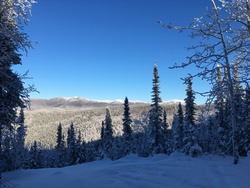 |
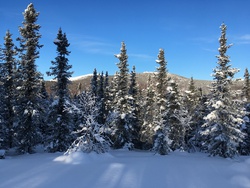 |
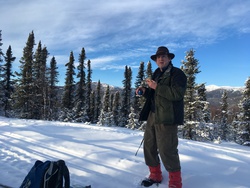 |
 |
The trail head parking is empty - which is not surprising. The only vehicles I've seen in this area are shuttle vans to the hot springs and trucks with snow machine laden trailers - but mainly on the weekends.
I deposit my $5 user fee in the "iron park ranger", clip on my skis, and head north.
At first I bundled tight; I am wearing ski boots, wool socks, knee brace, wool long johns, thick wool army pants, quilted thermal shirt, wool sweater, coat, gloves, over-mittens, scarf, ear muffs and a fedora. Half a mile later, my fingers are getting numb with cold, even with the over-mittens. It is -16-deg F.
But after a mile of a gradual up hill, my coat is unzipped, and the over mittens have been relegated to the backpack, and I am warm! In fact on the steeper up-hill climbs I break a sweat, and am working on strategies to let heat out and stay dry. This becomes an important consideration for the whole day as I ski this ridge line; half a mile of climbing, half a mile flat and exposed, half a mile swooping down. All of these conditions want different combination of clothing and ventilation.
The trail has had snow machine traffic, but not recently. There is about two inches of new powder on top of the harder, packed, base. I am guessing that somebody snow machined into the Stiles Cabin last weekend. In any case it is easy skiing.
At one point I am facing a long climb when I remember that I am caring my "skiing skins". These are long strips of material which I strap and stick to the bottom of my skis. They use to be made of sealskins, but now are artificial. The strips have a stiff, short, fur with the "hair" pointing in one direction. This means it slides forwards easily, but is very resistive to sliding backwards. It means that instead of herringboneing up the hill I can simply walk. However it also means that I can't really swoop down the other side. Skins most certainly make an uphill easier, but they carry a real overhead. It is probably five or six minutes to stop, unpack the skins, attach them and start skiing, and then reverse the process once I reach the top. Another cost benefit calculation to add on top of my moister and heat management.
Most of this trip is on a ridge line, up and down, with generally a bit more up than down. As I climb the views become more common. Ahead I see a bare peak and hope that is my destination - but I know that was not promised in the trail description. It is birch in the protected areas, and black spruce on the exposed spine of the ridge.
I finally reach my destination, the high point of this ridge. The bare peak is part of a different ridge and still a mile or more north of me. We are separated by a small valley and a lot of snow. My guide book, written for the summer, describes an unmaintained track between the peaks, but it is not clear if any snow machine has made the passage. Off my trail, even with skis on, I sink in two to three feet of snow.
And the day is moving on.
So I ski back about a mile to a very nice view for lunch.
My thermos has a history of keeping my tea scalding hot. But today it is just tepid. I guess -16F is a bit of a challenge. My sandwich is frozen. I've seen sled dog gnaw on their frozen food with relish and right now I completely understand. Still, after half a sandwich and two cups of tea I am starting to cool off and so I head out.
In addition to heat management and climbing skin choices, I also have time management. I would like to be off trail by 5:00pm. Actually there is a lot of margin in that constraint. We have been gaining 6-7 minutes of daylight every day. So a week ago 5:00 was twilight but now I have more than an extra hour. In my backpack I have two head lamps and a down sleeping bag. But the plan is just to leave them there.
The return is again a roller coaster, but with more down than up and I find myself easily making three to four miles an hour! One swooping downhill is so fast that I loss my hat and had to go back a bit to retrieve it!
So with two miles to go, I stop by the trail, sit on my ground cloth in a vast birch grove, and soak in the stillness of the wilderness for a long break.
I reached the trailhead at 4:59 - and the rest is simplicity.
Black Rapids Lodge
When we asked people about outings, Kristina and I have both been told about Black Rapids Lodge. On the web it looked like an interesting place to spend the night. But this is Valentines weekend, and the possibility of an openings seems vanishingly small. However, they have had a cancelation.
 |
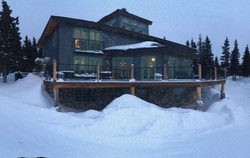 |
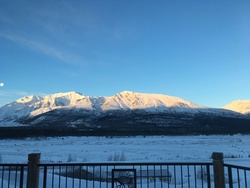 |
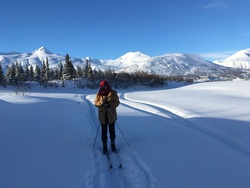 |
We have also been told that the drive there is half the reason to go. So we quickly put ourselves together so we will arrive in daylight, and are soon out the door.
It is 90 miles to Delta Junction and our road skirts the north edge of the Tanana river valley. Delta is the north end of the Alaskan Highway, where that 1940's road joins the older Richardson Highway (Fairbanks to Valdez). It is named for the junction of the Delta River and the Tanana River. The town itself is a scattering of a dozen businesses.
Now it is 37 miles south on the Richardson Highway, following the Delta River. Half this drive is across the flat bottom lands of the Tanana basin, with the Alaskan Range towering in front of us. Then, finally, we are into the mountains!
These mountains are rugged and make me think of the Alps. But the valley of the Delta River is broad and puts me more in mind of the Rockies. If we were in Colorado, this basin would be called a "Park".
At mile 37, next to the road, is the old Black Rapids Roadhouse. This is a log building which was built at the same time as the Richardson Highway, in 1898. The present owners of the Lodge did a lot of restoration on the roadhouse about 20 years ago. But then in 2006 turned their attention to building a new lodge. So up the hill, behind the roadhouse is the Black Rapids Lodge.
When we checked in, there is only another hour or so of daylight, so I grabbed a pair of snow shoes and go for a walk up through the spruce. With the snow coming down, the mountains are disappearing even before the sun goes.
It is a modern "Great Lodge". It has only six guest rooms, and two common tables for dining. There is no place else to eat within 37 miles, so we all eat together. Which makes it very communal place. The first floor is the kitchen, dining and great room. The second floor is guest rooms. And the third floor is like a large cupola, or a short squat tower on the lodge. Packed with books and two chaise lounge chairs, it is a good spot to read.
A couple have started playing guitars and singing in the great room. An artist, her aunt and the lodge owner are hanging her paintings throughout the lodge. The peaks have disappeared into the night.
At dinner we shared a table with the two musicians, the artist, the aunt and the owner. The artist and aunt were full of stories about growing up in a native village, and what it was like having mixed blood.
When we went to bed the snow was lighter and I could see the outlines of the peaks across the park.
In the morning the world is glacier blue! I opened the French Doors of our room to let the mountain colors in. Then crawled back under the quilt with a mug of coffee - it is about -10 F outside. First the peaks are touched by sun, and then the light slowly walks its way down the slopes. One likes to say "Golden Sunshine", but this really was orange.
A full breakfast of waffles, eggs, bacon and more, and it was time to pack and say many farewells.
We drove south towards Valdez and Isabel Pass, but stopped after ten miles at the trailhead for the Castner Glacier. This glacier is a mile and a quarter from the road, and apparently the most accessible glacier in Alaska. We strapped on our skis and planned on skiing up the trail to the glacier. We skied about half way there, but this trail, which goes up the frozen river is very exposed to the wind, which is howling right now. We reasoned that we could see the glacier, turned around and sought shelter.
The drive back to Fairbanks was simple, with a single stop at the Big Delta Brewery for lunch. And then home.
Bush Mail to Central and Circle
To me, "Bush Pilot", is one of those Alaskan institutions filled with frontier mystic. I'll confess, I'm not bold enough to order up a flight to the Lost Lake in the deep north wilderness. I don't know who to ask, or how to start.
 |
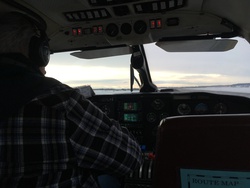 |
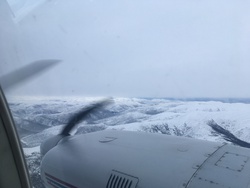 |
 |
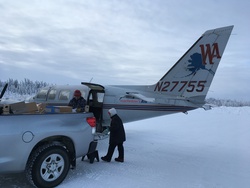 |
 |
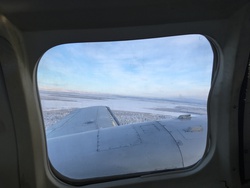 |
 |
I have also been told that to an Alaskan, flying is as common as taking a bus. There are villages which you can only fly, or mush, to. And there are a lot of small planes going in and out of the Fairbanks Airport all the time.
So with a little bit of searching, I finally found Warbelow's Airline, which runs a "commuter service" to many remote villages. It also carries the mail, and if they have an empty seat you can ride with the "Bush Mail" to a village and back again. So I called Warbelow's on Monday, and got a seat for Tuesday to Central and Circle.
When I checked in the office manager asked if I was Tim. I said yes, and asked if she guessed that because I was the only one on the flight. She said, "No, but you are the only one I don't recognize."
Warbelow's shares a building with "North Alaska Tours", so when I arrived the waiting room was filled with eight tourist who were going to fly to Coldfoot, above the Arctic Circle, and then a van would drive them back to Fairbanks on the Dalton (pipeline) Highway, through the night, looking for Aurora. It sounded so rushed to me, trying to cram into three days, what I hope to see in three months.
After they left, it was just Lawrence and myself waiting for our flight. The Warbelow manager had me stand on the scale so they could balance the flight. Eventually Matt, our pilot arrived, returning from the morning flight, and introduced himself. And in a few minutes, Matt, Lawrence, myself and a lot of boxes and mailbags were aboard a Piper Navajo Chieftain. This is a twin engine plane which could accommodate eight passengers, but half the seats had been pulled to make space for the cargo.
The flight starts with a wide circle south, out over the Tanana flood plains, miles and miles of "sloughs" and frozen bogs, or perhaps more correctly, a "muskeg". We curved back over Fairbanks, then drew a line someplace between the Chena River to the south and the Chatanika River and Steese Highway to the north.
You can drive to Central and Circle on Steese Highway, so there are less passengers on this flight. But it is a hundred miles of a lonely wilderness road and I am happy to be in the air. Below me I occasionally spot an isolated cabin, but with less frequency as the miles pass.
Porcupine Dome, Mastodeon Dome, Rosebud, Eagle Summit. The term "Dome" is descriptive and common in this area. These are high hills, or small mountains, or perhaps you could even call them "fells".
The peaks get higher, icier and more barren until we cross over into the Yukon Basin. And then it is a pretty aggressive descent into Central.
As we are sitting on the airstrip, I mention to Matt that all I really know about Central is that it was a checkpoint on the Yukon Quest. He asked me what I knew of the Quest and I mentioned that I had volunteered at the Two Rivers Checkpoint. That seemed to open a lot of doors.
When the propellers stopped, a pickup truck backed up to the airplane. I asked Matt if there was anything I could do to help, and he said "Sure". First, he introduced me to Dee, the postmaster for Central. Then with Matt in the back of the airplane, Dee standing in the bed of her truck, and myself in the middle, we relayed the mail bags and boxes to the truck. Six to eight mailbags and thirty boxes, half of them from Amazon, went into the truck. Empty mailbags, and one bag with a handful of letters were returned.
When we are airborne again Matt ask Lawrence if he doesn't mind taking the scenic route. "No, I'm in no rush", Lawrence replied.
Lawrence is a local Native American, and keeps the wells in the Circle Water District working. When I saw the miles of "Muskeg" (Bog) around the Yukon, it was hard the imagine wells and water districts. Actually Lawrence use to be the head of the district. But now he is semi-retired and is the assistant to the head of the district.
The "Scenic Route" is down the course of Birch Creek. This creek meanders like a drunk. A canoe would travel three times the distance the airplane flys. And so would a dogsled!
The Piper Chieftain flies about 200m above the valley floor and I can easily see the tracks of the sleds from the Yukon Quest. They cut close to the inside of one bend, then steer diagonally across the next reach so as to curve closely to the opposite bend.
Birch Creek parallels the Yukon, so eventually Matt bears to the east and makes a straight line to Circle.
A century ago there were a number of "Gold Rushes" in the Yukon and Alaska, including the Birch Creek Rush, which made Circle a boom town. Today it has a population of about 90, and three of them came out to meet us and Lawrence. They unpacked the rest of the plane's cargo - similar to the amount from Central, and then climbed into two trucks and trundled off. Leaving Matt and myself on the airstrip.
It is a beautiful, clear, crisp - and very cold day. But Matt and I talked until we were both chilled, maybe twenty minutes. He loves this country and told me a great deal about the geology of Alaska. He told me that the Brooks Range, to the north, was the true continuation of the Cascades, where as the Alaskan Range, to the south, is a new commer. A completely different tectonic event.
He also talked about how humans crossed into Alaska during an ice age, when the Bearing Sea was low. But they were hemmed in by ice, and so stayed in the Yukon basin for generations.
But then it was time for us to head back to Fairbanks.
On route he circled the Fort Knox mine and rolled the plane so I could see how deep the pit was. The Alaskan Gold rushes continue.
And then we were on the ground. A family of six were waiting for Matt to fly them to the village of Beaver, and so I headed home.